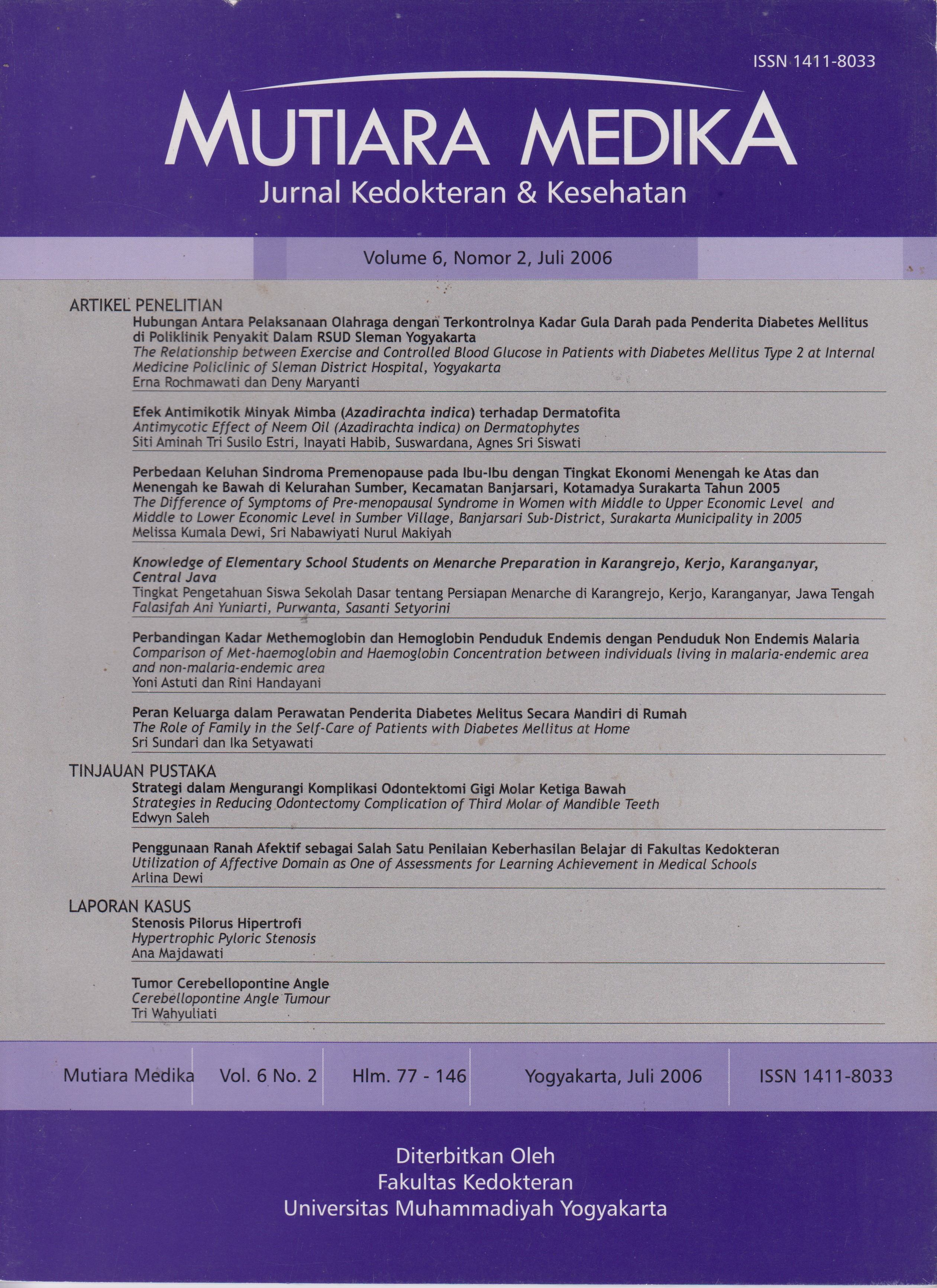Perbedaan Keluhan Sindroma Premenopause pada Ibu-Ibu dengan Tingkat Ekonomi Menengah ke Atas dan Menengah ke Bawah di Kelurahan Sumber, Kecamatan Banjarsari, Kotamadya Surakarta Tahun 2005
DOI:
https://doi.org/10.18196/mmjkk.v6i2.1888Keywords:
keluhan sindroma premenopause, ibu-ibu tingkat ekonomi menengah ke atas, ibu-ibu tingkat ekonomi menengah ke bawah, symptoms of pre-menopausal syndrome, women with middle to upper economic levelAbstract
Menopause is the last menstrual period or when the last menstrual period occurs. Many symptoms occur in a woman undergoing this period which can cause anxiety andfears. The aim of this research was to compare the symptoms of pre-menopausal syndrome in women with middle to upper economic level and women with middle to lower economic level in Sumber Village, Banjarsari Sub-district, Surakarta in 2005.This was an analytical descriptive study with a cross-sectional design. Primary data was obtained by directly administering a questionnaire on the symptoms of pre-menopausal syndrome to 60 respondents. The data was then analyzed using Chi-Square test.
The result of this study showed that out of 19 pre-menopausal syndrome symptoms, the symptoms of restless, easily offended, bad temper, disturbed concentration, difficulty of sleeping, stress, itchy and hot flushes had significant differences between women with middle to upper economic level and women with middle to lower economic level. Meanwhile, the symptoms of fear, disturbed libido, dry skin, wrinkles, fragile nails, dry mouth, thinning hair, growth of hair around mouth, nose and ear; excessive sweating, palpitation and headache did not show any significant differences. There is a difference of types of pre-menopausal syndrome symptoms between women with middle to upper economic level and women with middle to upper economic level. The symptoms of pre-menopausal syndrome occur more in women with middle to upper economic level than in women with middle to lower economic level.
Menopause adalah haid terakhir atau saat teij adinya haid terakhir. Banyak keluhan dialami seorang wanita pada masa menopause yang dapat menimbulkan kecemasan dan ketakutan. Penelitian ini bertujuan untuk mengetahui perbedaan j enis keluhan sindroma premenopause pada ibu-ibu dengan status ekonomi menengah ke atas dan menengah ke bawah di Kelurahan Sumber, Kecamatan Banjarsari, Kotamadya Surakarta tahun 2005.
Penelitian ini bersifat deskriptif analitik dengan pendekatan cross sectional. Data bersifat primer diperoleh dengan menggunakan angket/kuesioner berisi j enis keluhan sindroma premenopause pada 60 responden secara langsung. Data dianalisis dengan uji statistik Chi Kuadrat.
Hasil penelitian menunjukkan bahwa dari 19jenis keluhan sindroma premenopause, untukkeluhan gelisah, mudah tersinggung, mudah marah, konsentrasi terganggu, susah tidur, stres, gatal, dan munculnya gejolak panas menunjukkan ada perbedaan bermakna, sedangkan keluhan takut, gangguan libido, kulit kering, keriput, kuku rapuh, mulut kering, rambut menipis, tumbuhnya rambut di sekitar mulut, hidung, telinga, keringat berlebih, jantung berdebar-debar dan sakit kepala menunjukkan tidak terdapat perbedaan bermakna. Terdapat perbedaan jenis keluhan sindroma premenopause pada ibu-ibu dengan status ekonomi menengah ke atas dan menengah ke bawah. Keluhan-keluhan sindromapremenopause tersebut lebih banyak dirasakan oleh ibu-ibu dengan status ekonomi menengah ke atas daripada ibu-ibu dengan status ekonomi menengah ke bawah.
References
Sastrawinata, S. 2002. Wanita dalam Berbagai Masa Kehidupan dalam Prawirohardjo, S., : Ilmu kandungan Ed.3.Yayasan Bina Pustaka Sarwono Prawirohardjo, Jakarta, hal. 130.
Riphagen, F.E., 1985. Perimenopause : A Review. Kongres Obstetri dan Ginekologi Indonesia VI. Ujung Pandang.
Damodaran, 2001. Profile of Menopause Clinic in an Urban Population in Malaysia. Singapore Med J. 41(9): 431-435. http:// www.sma.org.sg/smi/41 09/ 4109a1.pdf.
Darajat, Z. 1973. Menghadapi Masa Menopause. Penerbit Bulan Bintang, Jakarta.
Notoatmodjo, S. 2002. Metodologi Penelitian Kesehatan. Edisi Revisi. Rineka Cipta. Jakarta, hal 26-27, 86.
Arikunto, S. 2002. Prosedur Penelitian Suatu Pendekatan Praktek. Edisi V. Rineka Cipta. Jakarta, hal 128.
Yudomustopo, B. 1989. Pemeriksaan Ginekologik Menjelang Menopause. Simposium Menopause RS. Pusat Pertamina. Jakarta, hal 11.
Wijayati, T. 2005. Hubungan Tingkat Pengetahuan Ibu tentang Menopause dengan Keluhan Ibu di Wilayah Puskesmas Rongkop Kabupaten Gunungkidul Tahun 2005. Skripsi. Jurusan Kebidanan Politeknik Kesehatan Yogyakarta.Yogyakarta. hal 12-13.
Utian, 2005. Psychosocial and Socioeconomic Burden of Vasomotor Symptoms in Menopause: A Comprehensive Review, http:// www.obavn.net/meno/meno. asp?paae=/meno articles/ vasomotor_utian.
Kristin, 1997. Frekuensi Depresi pada Wanita Pasca Menopause di Lingkungan Guru SD Kotamadya Yogyakarta. Skripsi. Fakultas Kedokteran UGM. Yogyakarta.
Paat, G. !989. Permasalahan Seksual dalam Masa Menopause dan Purna Menopause. Simposium Menopause RS. Pusat Pertamina. Jakarta, hal 25.
Muhammad, A. 2005. Problema Fisiologik Pada Menopause. Jurnal Teknologi Kesehatan. Vol.1. No 1. Poltekkes Yogyakarta, Yogyakarta, hal 64.
Nuryati, 2002. Menopause Dalam Amatan Psikologis, Seminar Sehari Memperingati Hari Menopause Sedunia. Yogyakarta.
Retnowati.S. 2000. Sebuah Tinjauan Psikologis, Tetap Bergairah Memasuki Usia Menopause. Seminar Ilmiah Populer Menyambut Hari Menopause Sedunia. Yogyakarta.
Downloads
Issue
Section
License
Copyright
Authors retain copyright and grant Mutiara Medika: Jurnal Kedokteran dan Kesehatan (MMJKK) the right of first publication with the work simultaneously licensed under an Attribution 4.0 International (CC BY 4.0) that allows others to remix, adapt and build upon the work with an acknowledgment of the work's authorship and of the initial publication in Mutiara Medika: Jurnal Kedokteran dan Kesehatan (MMJKK).
Authors are permitted to copy and redistribute the journal's published version of the work (e.g., post it to an institutional repository or publish it in a book), with an acknowledgment of its initial publication in Mutiara Medika: Jurnal Kedokteran dan Kesehatan (MMJKK).
License
Articles published in the Mutiara Medika: Jurnal Kedokteran dan Kesehatan (MMJKK) are licensed under an Attribution 4.0 International (CC BY 4.0) license. You are free to:
- Share — copy and redistribute the material in any medium or format.
- Adapt — remix, transform, and build upon the material for any purpose, even commercially.
This license is acceptable for Free Cultural Works. The licensor cannot revoke these freedoms as long as you follow the license terms. Under the following terms:
Attribution — You must give appropriate credit, provide a link to the license, and indicate if changes were made. You may do so in any reasonable manner, but not in any way that suggests the licensor endorses you or your use.
- No additional restrictions — You may not apply legal terms or technological measures that legally restrict others from doing anything the license permits.






